Neolentinus lepideus (Fr.) Redhead & Ginns - Train Wrecker
Phylum: Basidiomycota - Class: Agaricomycetes - Order: Polyporales - Family: Polyporaceae
Distribution - Taxonomic History - Etymology - Identification - Culinary Notes - Reference Sources
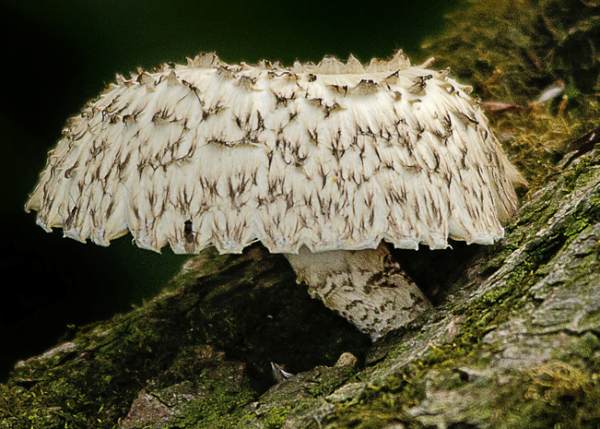
Neolentinus lepideus, a gilled member of the family Polyporaceae, is one of the few fungi species that can cope with creosote and other preserving impregnations that are used in an attempt to prevent structural timbers from rotting. Its common name Train Wrecker reflects the fact that this wood-rotting fungus can attack and consume railway sleepers.
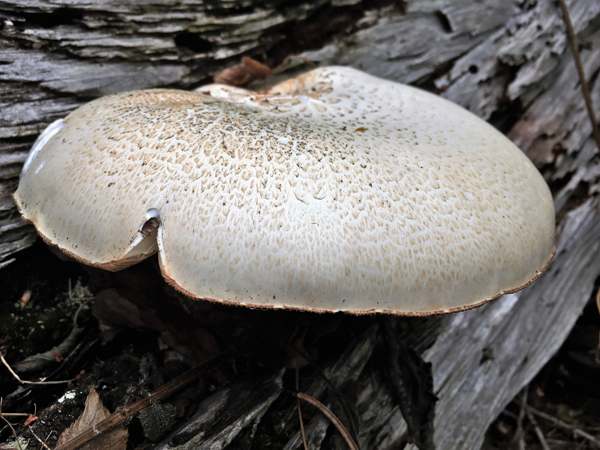
Distribution
Neolentinus lepideus is an occasional find in Britain and Ireland. Thie range of this species extends across much of mainland Europe and Africa, and it is also recorded in many parts of Asia and North America.
Taxonomic history
The Train Wrecker was described scientifically in 1815 by Swedish mycologist Elias Magnus Fries, who created its basionym when he gave it the scientific binomial name Agaricus lepideus. Thirteen years later, in 1828, Christiaan Hendrik Persoon described the same species under the scientific name Agaricus polymorphus. The currently-accepted scientific name dates from a 1985 publication by Canadian mycologists Scott Alan Redhead and Jim Ginns.
Working out which family and genus this gilled mushroom belongs in has foxed mycologists down the centuries - hence its many and very varied synonyms, which include include Agaricus lepideus Fr., Lentinus lepideus (Fr.) Fr., Clitocybe lepidea (Fr.) P. Kumm., Pocillaria lepidea (Fr.) Kuntze, Panus lepideus (Fr.) Corner, Agaricus tubaeformis Schaeff., Agaricus cyprinus Batsch, Agaricus serpentiformis Batsch, Ramaria ceratoides Holmsk., and Agaricus polymorphus Pers.
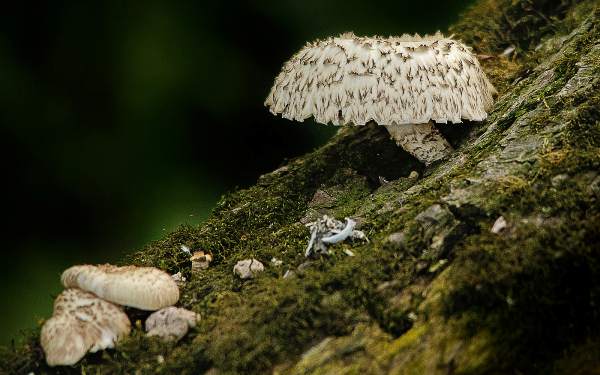
Etymology
The generic name Neolentinus comes from Neo- meaning 'a modern or recent version of' and Lentinus, a gilled mushroom genus within the family Polyporaceae, via the Latin lent- meaning pliable and -inus meaning resembling.
The specific epithet lepideus is a Latin adjective meaning scaly - a reference to the structure of the cap surface.
Identification guide
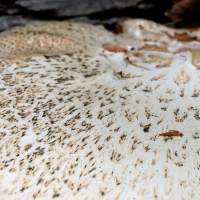 |
CapThe upper surface of the cap of this gilled polypore is white with coarse brown scales, larger towards the centre. Ranging from 3 to 12cm across when fully developed, but sometimes split and lobed, the caps are initially convex with an inrolled margin, expanding to become flat with age. |
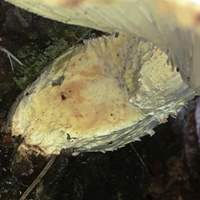 |
Stem2.5-15cm long and 1-2cm in diameter; dry; whitish, developing brown scales. The fleeting stem ring can sometimes be difficult to discern because it looks very similar to the stem scales. |
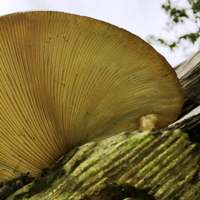 |
GillsAdnate, white to yellowish; edges raggedly serrate; bruising brownish. |
SporesCylindrical, smooth, 8-14 x 3.5-5µm; inamyloid. Spore printWhite. |
|
Odour/taste |
Odour sometimes faintly of aniseed; taste mild but not distinctive. |
Habitat & Ecological role |
Saprobic, causing brown rot in trunks, stumps and fallen large branches of conifers, particularly pines (Pinus spp) and larches (Larix spp) very occasionally also on hardwoods; also on railway sleepers and telegraph poles. |
Season |
Early summer to late autumn |
Similar species |
There are other similar members of the genus Neolentinus; however, Neolentinus lepideus is the only member of its genus that has a stem ring. |
Culinary Notes
This is a rare find of uncertain edibility and hence of no culinary interest.
Reference Sources
Mattheck, C., and Weber, K. (2003). Manual of Wood Decays in Trees. Arboricultural Association
Pat O'Reilly (2016). Fascinated by Fungi, First Nature Publishing
BMS List of English Names for Fungi
Paul M. Kirk, Paul F. Cannon, David W. Minter and J. A. Stalpers. (2008). Dictionary of the Fungi; CABI.
Taxonomic history and synonym information on these pages is drawn from many sources but in particular from the British Mycological Society's GB Checklist of Fungi.
Acknowledgements
This page includes pictures kindly contributed by David Adamson and Simon Harding.
Fascinated by Fungi. Back by popular demand, Pat O'Reilly's best-selling 450-page hardback book is available now. The latest second edition was republished with a sparkling new cover design in September 2022 by Coch-y-Bonddu Books. Full details and copies are available from the publisher's online bookshop...

